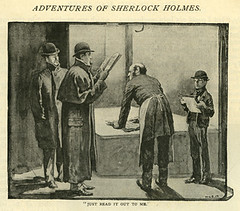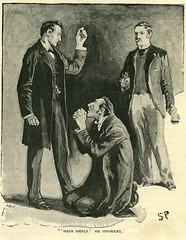
The name Sherlock Holmes instantly calls to mind the detective clad in a deerstalker cap and inverness cape with the astonishing ability to solve crimes through reason and logic. Though Sherlock Holmes remains an intensely popular figure, few today are aware of the origins of his character or the iconic image that we associate with Holmes.
Motivated by the decrease in paper prices and increase in literacy that occurred towards the end of the nineteenth century, George Newnes founded The Strand magazine in 1891. The Strand’s target audience was the growing number of men living in the suburbs surrounding London, who therefore had to ride a train to and from the city each day. The Strand could be purchased in railway bookstores and featured short stories that were brief enough to be read during the ride home. When Newnes asked Sir Arthur Conan Doyle to contribute short stories to The Strand, Doyle had the idea to write a self-contained story for each copy, while continuing the characters from issue to issue. In this way, Doyle resolved the central flaw of serialized novels: if readers missed an issue, they would miss key plot events, which meant they might lose interest in the story entirely. Doyle’s strategy was successful. The Strand generally circulated 300,000 copies, but when a Sherlock Holmes story was featured, circulation instantly increased to 500,000.

Newnes also solicited Sidney Paget to contribute illustrations to accompany Doyle’s writing. Newnes insisted that the illustrations be central to the story. For each Holmes short story, Newnes required an illustration on every spread, if not on every page. Paget represented Holmes as tall and slender, frequently smoking a pipe. Watson was stout with a prominent mustache. Paget’s illustrations are responsible for the images we traditionally associate with Sherlock Holmes and Dr. Watson today.
Special Collections owns two runs of The Strand magazine, as well as an issue from the American edition of the magazine.

